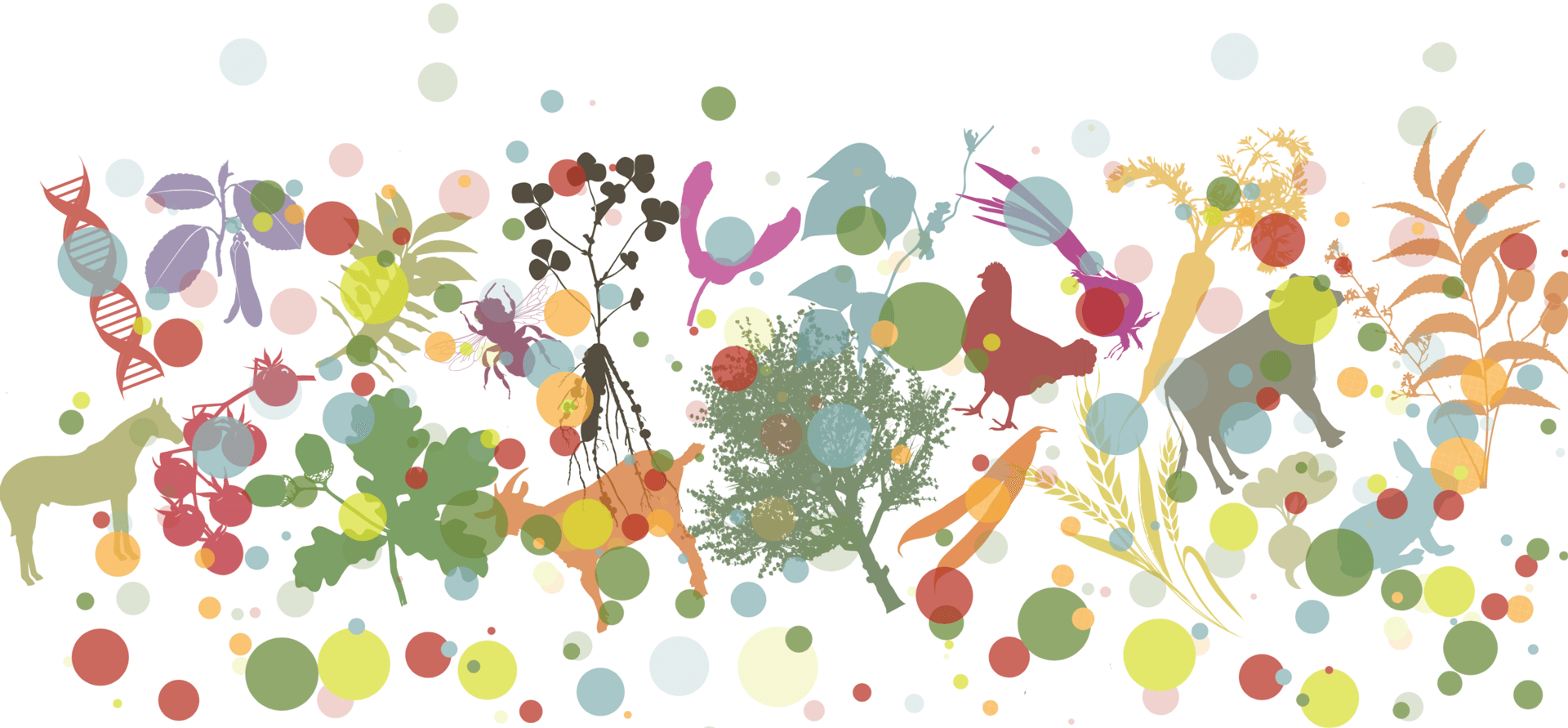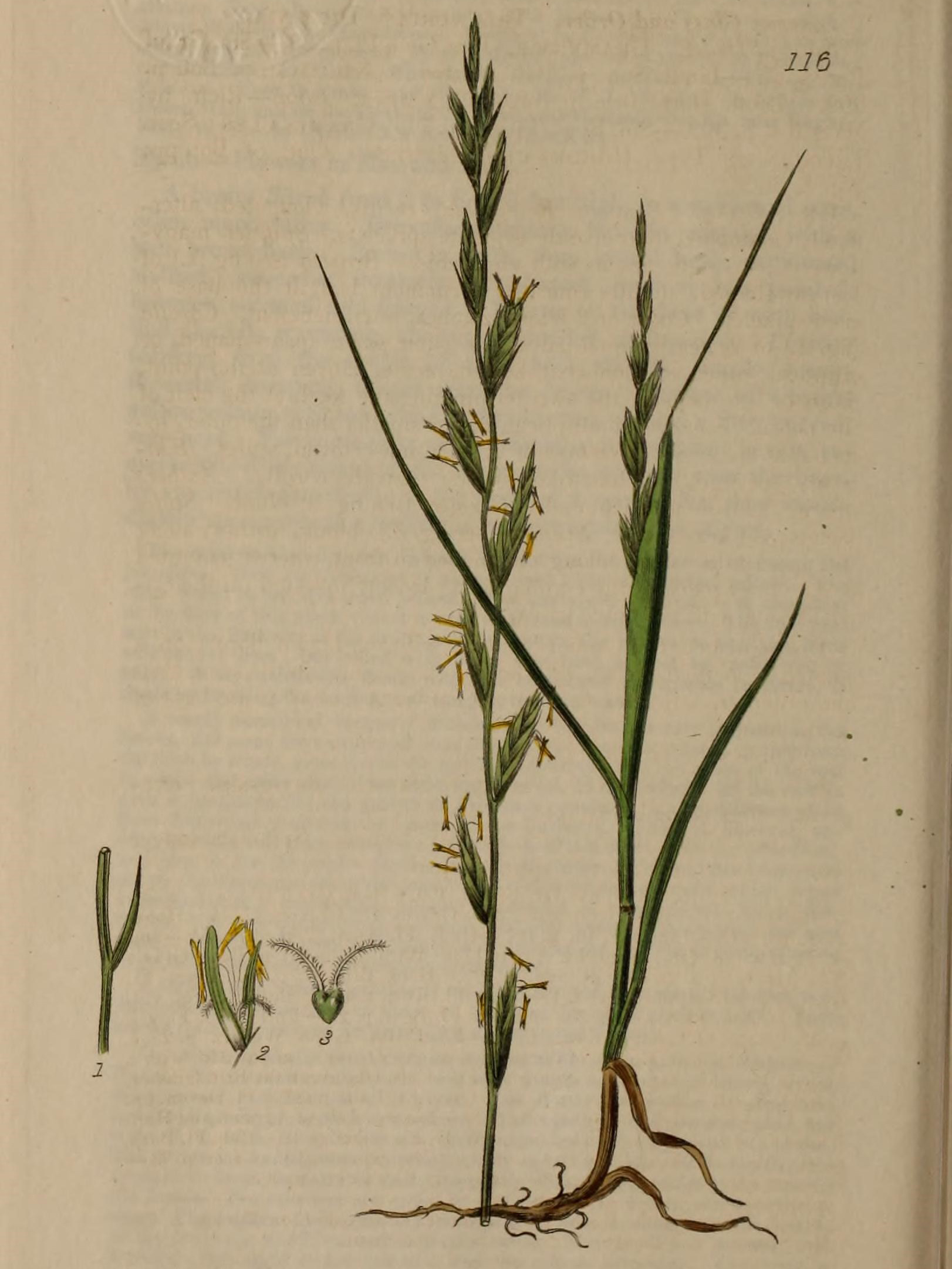Phenotypic traits in natural perennial ryegrass populations and relations to climate conditions at sites of origins across Europe
Main Article Content
Abstract
Perennial ryegrass (Lolium perenne L.) is one of the most important forage grass species in temperate climates. However, natural perennial ryegrass populations have been exploited to only a limited extent by breeders. Therefore, 41 ecotypic Lolium perenne populations collected across Europe were studied for their agronomic performance in a 3-year common garden experiment located in north-eastern Germany (Poel Island, Mecklenburg Western Pomerania). Agronomic performances were evaluated on 30 plants per population for 11 traits related to forage value and environmental adaptation. Population means for studied traits were correlated to the values of climate variables at their collection sites. Populations clearly differed in their phenotypic performance, and eight populations originating from Belgium, France and Germany outperformed the other populations by showing the lowest winter damage, strongest spring growth and regrowth capacity after cuts and low disease susceptibility. Specifically, in the first experimental year, trait performances, in particular winter damage, spring growth and heading date, were related to the local climate at the site of origin of populations. Acclimation to the climate conditions at the experimental site might explain why these correlations were less pronounced in the second and third experimental years. The characterized populations might now be considered to improve specific traits in breeding.
Article Details

This work is licensed under a Creative Commons Attribution 4.0 International License.
Authors retain copyright of the articles published in Genetic Resources and grant the journal right of first publication with open access. All articles published in Genetic Resource are licensed under Creative Commons Attribution 4.0 International License (CC BY 4.0) that allows others to download, share and adapt the work for commercial and non-commercial purposes as long as proper attribution to the original article is given. Genetic Resources permits and encourages authors to post items submitted to the journal (including the publisher's final layout) on personal websites or institutional repositories after acceptance and/or publication, while providing bibliographic details that credit their publication in Genetic Resources.
Arojju, S K et al. (2016). “Markers associated with heading and aftermath heading in perennial ryegrass full-sib families”. BMC Plant Biol 16(1), p. 160. DOI: https://doi.org/10.1186/s12870-016-0844-y. DOI: https://doi.org/10.1186/s12870-016-0844-y
Bachmann-Pfabe, S, E Willner, and K J Dehmer (2018). “Ex-situ evaluations of Lolium perenne L. ecotypes collected in Bulgaria, Croatia, Spain and Ireland reveal valuable breeding material”. Genet Resour Crop Evol 65(5), pp. 1423–1439. DOI: https://doi.org/10.1007/s10722-018-0623-8. DOI: https://doi.org/10.1007/s10722-018-0623-8
Barre, P et al. (2018). “Natural diversity in vegetative and reproductive investments of perennial ryegrass is shaped by the climate at the place of origin”. Grass Forage Sci 73(1), pp. 193–205. DOI: https://doi.org/10.1111/gfs.12304. DOI: https://doi.org/10.1111/gfs.12304
Blackmore, T et al. (2016). “Germplasm dynamics. The role of ecotypic diversity in shaping the patterns of genetic variation in Lolium perenne”. Sci Rep 6(1), pp. 22603–22603. DOI: https://doi.org/10.1038/srep22603. DOI: https://doi.org/10.1038/srep22603
Blanco-Pastor, J L, P Barre, et al. (2021). “Canonical correlations reveal adaptive loci and phenotypic responses to climate in perennial ryegrass”. Mol Ecology Res 21(3), pp. 849–870. DOI: https://doi.org/10.1111/1755-0998.13289. DOI: https://doi.org/10.1111/1755-0998.13289
Blanco-Pastor, J L, S Manel, et al. (2019). “Pleistocene climate changes, and not agricultural spread, accounts for range expansion and admixture in the dominant grassland species Lolium perenne L”. J Biogeogr 57, pp. 1451–1465. DOI: https://doi.org/10.1111/jbi.13587. DOI: https://doi.org/10.1111/jbi.13587
Bothe, A et al. (2018). “Drought tolerance in perennial ryegrass (Lolium perenne L.) as assessed by two contrasting phenotyping systems”. J Agro Crop Sci 204(4), pp. 375–389. DOI: https://doi.org/10.1111/jac.12269. DOI: https://doi.org/10.1111/jac.12269
Charmet, G and F Balfourier (1991). “Further evaluation of exotic germplasm of perennial ryegrass for use in French plant breeding programmes”. Euphytica 57, pp. 67–76. DOI: https://doi.org/10.1007/BF00040479
Crush, J R et al. (2010). “Comparisons between wild populations and bred perennial ryegrasses for root growth and root/shoot partitioning”. N Z J Agric Res 52(2), pp. 161–169. DOI: https://doi.org/10.1080/00288230909510500. DOI: https://doi.org/10.1080/00288230909510500
DWD (2023a). Lufttemperatur: vieljährige Mittelwerte 1991-2020 (Air temperature: multi-year averages 1991-2020). Deutscher Wetterdienst (German Meteorological Service). URL: https://www.dwd.de/DE/leistungen/klimadatendeutschland/mittelwerte/temp_9120_SV_ html.html;jsessionid=A0884716A72FBAF86F1C170D14392E03.live21062?view= nasPublication%5C&nn=16102.
DWD (2023b). Niederschlag: vieljährige Mittelwerte 1991-2020 (Precipitation: multi-year averages 1991 – 2020). Deutscher Wetterdienst (German Meteorological Service). URL: https://www.dwd.de/DE/leistungen/klimadatendeutschland/mittelwerte/nieder_9120_ fest_html.html?view=nasPublication.
FAO/Bioversity (2015). FAO/Bioversity multi-crop passport descriptors V.2.1. URL: https://hdl.handle.net/10568/69166.
Fox, J and S Weisberg (2011). An R companion to applied regression. URL: http://socserv.socsci.mcmaster.ca/jfox/Books/Companion.
Fuller, M P and C F Eagles (1980). “The effect of temperature on cold hardening of Lolium perenne seedlings”. The Journal of Agricultural Science 95(1), pp. 77–81. DOI: https://doi.org/10.1017/S0021859600029300
Goslee, S C, J M Gonet, and R H Skinner (2017). “Freeze tolerance of perennial ryegrass and implications for future species distribution”. Crop Sci 57(5), pp. 2875–2880. DOI: https://doi.org/10.2135/cropsci2017.02.0135. DOI: https://doi.org/10.2135/cropsci2017.02.0135
Gross, J and U Ligges (2015). Package "nortest". Tests for normality. URL: https://cran.r-project.org/web/packages/nortest/nortest.pdf.
Harrell, F E (2021). Package “Hmisc”. Harrel Miscellaneous. URL: https://CRAN.R-project.org/package=Hmisc.
Hulke, B S, E Watkins, D L Wyse, et al. (2008). “Freezing tolerance of selected perennial ryegrass (Lolium perenne L.) accessions and its association with field winterhardiness and turf traits”. Euphytica 163(1), pp. 131–141. DOI: https://doi.org/10.1007/s10681-007-9631-z. DOI: https://doi.org/10.1007/s10681-007-9631-z
Hulke, B S, E Watkins, D Wyse, et al. (2007). “Winterhardiness and turf quality of accessions of perennial ryegrass (Lolium perenne L.) from public collections”. Crop Science 47(4), pp. 1596–1602. DOI: https://doi.org/10.2135/cropsci2006.10.0671. DOI: https://doi.org/10.2135/cropsci2006.10.0671
Humphreys, M O (1989). “Assessment of perennial ryegrass (Lolium perenne L.) for breeding. II. Components of winter hardiness”. Euphytica 41(1-2), pp. 99–106. DOI: https://doi.org/10.1007/BF00022418
Humphreys, M O and C F Eagles (1988). “Assessment of perennial ryegrass (Lolium perenne L.) for breeding. I Freezing tolerance”. Eyphytica 38, pp. 75–84. DOI: https://doi.org/10.1007/BF00024813
Humphreys, M O, U Feuerstein, et al. (2010). “Ryegrasses”. In: Fodder Crops and Amenity Grasses. Ed. by B Boller, U K Posselt, and F Veronesi. Vol. 5. New York, NY: Springer Science+Business Media LLC, pp. 211–260. DOI: https://doi.org/10.1007/978-1-4419-0760-8_10
Hurley, G, M O’Donovan, and T J Gilliland (2007). “Factors influencing ear initiation and ear emergence development of perennial ryegrass cultivars at two different latitudes”. In: A vibrant rural economy - The Challenge for Balance. Cork, Ireland: International Farm Management Association, pp. 393–401.
Keep, T, J P Sampoux, J L Blanco-Pastor, et al. (2020). “High-throughput genome-wide genotyping to optimize the use of natural genetic resources in the grassland species perennial ryegrass (Lolium perenne L.)” G3 10(9), pp. 3347–3364. DOI: https://doi.org/10.1534/g3.120.401491. DOI: https://doi.org/10.1534/g3.120.401491
Keep, T, J P Sampoux, P Barre, et al. (2021). “To grow or survive. Which are the strategies of a perennial grass to face severe seasonal stress?” Funct Ecol 35(5), pp. 1145–1158. DOI: https://doi.org/10.1111/1365-2435.13770. DOI: https://doi.org/10.1111/1365-2435.13770
Kemesyte, V et al. (2010). “Evaluation of Lolium perenne (L.) wild ecotypes of Ukrainian origin in Lithuania”. Agronomy Research 8((Special Issue)), pp. 615–624.
Kimbeng, C (1999). “Genetic basis of crown rust resistance in perennial ryegrass, breeding strategies, and genetic variation among pathogen populations: A review”. Animal Production Science 39, pp. 361–378. DOI: https://doi.org/10.1071/EA98111
Kreyling, J et al. (2012). “Geographic origin and past climatic experience influence the response to late spring frost in four common grass species in central Europe”. Ecography 35(3), pp. 268–275. DOI: https://doi.org/10.1111/j.1600-0587.2011.07173.x. DOI: https://doi.org/10.1111/j.1600-0587.2011.07173.x
Laidlaw, A S (2005). “The relationship between tiller appearance in spring and contribution to dry-matter yield in perennial ryegrass (Lolium perenne L.) cultivars differing in heading date”. Grass and Forage Sci 60(2), pp. 200–209. DOI: https://doi.org/10.1111/j.1365-2494.2005.00468.x
Lenth, R V (2016). “The R package lsmeans”. Journal of Statistical Software 69(1), pp. 1–33. DOI: https://doi.org/10.18637/jss.v069.i01. DOI: https://doi.org/10.18637/jss.v069.i01
McDonagh, J et al. (2016). “Genetic gain in perennial ryegrass (Lolium perenne L.) varieties 1973 to 2013”. Euphytica 212(2), pp. 187–199. DOI: https://doi.org/10.1007/s10681-016-1754-7. DOI: https://doi.org/10.1007/s10681-016-1754-7
McGrath, S et al. (2010). “Variation in inflorescence characters and inflorescence development in ecotypes and cultivars of Lolium perenne L”. Grass Forage Sci(65), pp. 398–409. DOI: https://doi.org/10.1111/j.1365-2494.2010.00759.x
Oliveira-Prendes, J A et al. (1997). “Genetic diversity of westerwold ryegrass landraces collected in Northwest Spain”. Genet Resour Crop Evol 44, pp. 479–487. DOI: https://doi.org/10.1023/A:1008680000878
R Core Team (2020). R: A Language and Environment for Statistical Computing. R Foundation for Statistical Computing. URL: https://www.r-project.org/.
Sampoux, J. -P, P Baudouin, B Bayle, V Béguier, P Bourdon, J F Chosson, K De Bruijn, et al. (2013). “Breeding perennial ryegrass (Lolium perenne L.) for turf usage. An assessment of genetic improvements in cultivars released in Europe, 1974-2004”. Grass Forage Sci 68(1), pp. 33–48. DOI: https://doi.org/10.1111/j.1365-2494.2012.00896.x. DOI: https://doi.org/10.1111/j.1365-2494.2012.00896.x
Sampoux, J. -P, P Baudouin, B Bayle, V Béguier, P Bourdon, J F Chosson, F Deneufbourg, et al. (2011). “Breeding perennial grasses for forage usage. An experimental assessment of trait changes in diploid perennial ryegrass (Lolium perenne L.) cultivars released in the last four decades”. Field Crops Research 123(2), pp. 117–129. DOI: https://doi.org/10.1016/j.fcr.2011.05.007. DOI: https://doi.org/10.1016/j.fcr.2011.05.007
Sampoux, J. -P. and V Badeau (2010). “Empirical Niche Modelling of the Spontaneous Diversity of Forage and Turf Species to Improve Collection and Ex Situ Conservation”. In: Sustainable use of Genetic Diversity in Forage and Turf Breeding. Ed. by C Huyghe. Dordrecht: Springer Science+Business Media B.V., pp. 29–40. DOI: https://doi.org/10.1007/978-90-481-8706-5_3
W Wilkins, P and M O Humphrey (2003). “Progress in breeding perennial forage grasses for temperate agriculture”. Journal of Agricultural Science 140, pp. 129–250. DOI: https://doi.org/10.1017/S0021859603003058
Warnes, G R et al. (2020). gplot: Various R programming tools for plotting data. URL: https://CRAN.R-project.org/package=gplots.
Willner, E, S Hünmörder, and K J Dehmer (2010). “Towards an enhanced utilization of plant genetic resources in grass breeding by characterization and evaluation trails”. In: Sustainable use of Genetic Diversity in Forage and Turf Breeding. Ed. by C Huyghe. Dordrecht: Springer Science+Business Media B.V., pp. 173–180. DOI: https://doi.org/10.1007/978-90-481-8706-5_25
Zeileis, A (2004). “Econometric Computing with HC and HAC Covariance Matrix Estimators”. Journal of Statistical Software 11(10), pp. 1–17. DOI: https://doi.org/10.18637/jss.v011.i10







 This journal has been conceived as part of the
This journal has been conceived as part of the